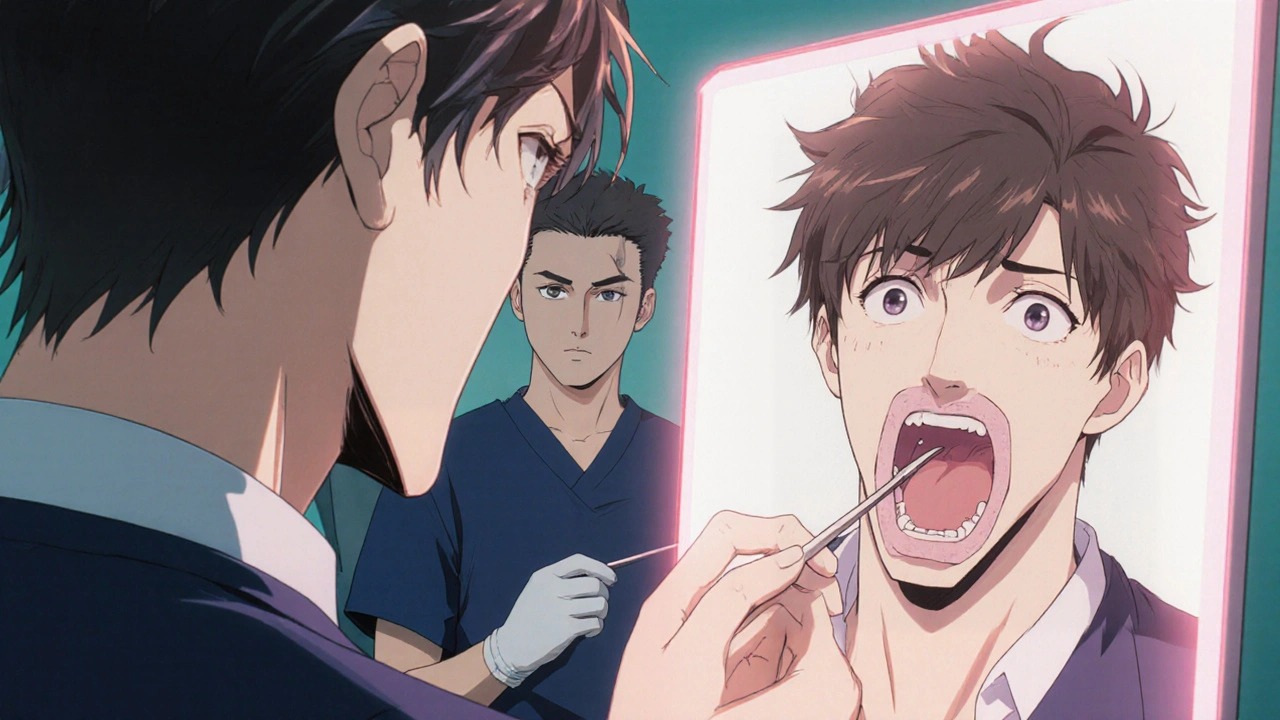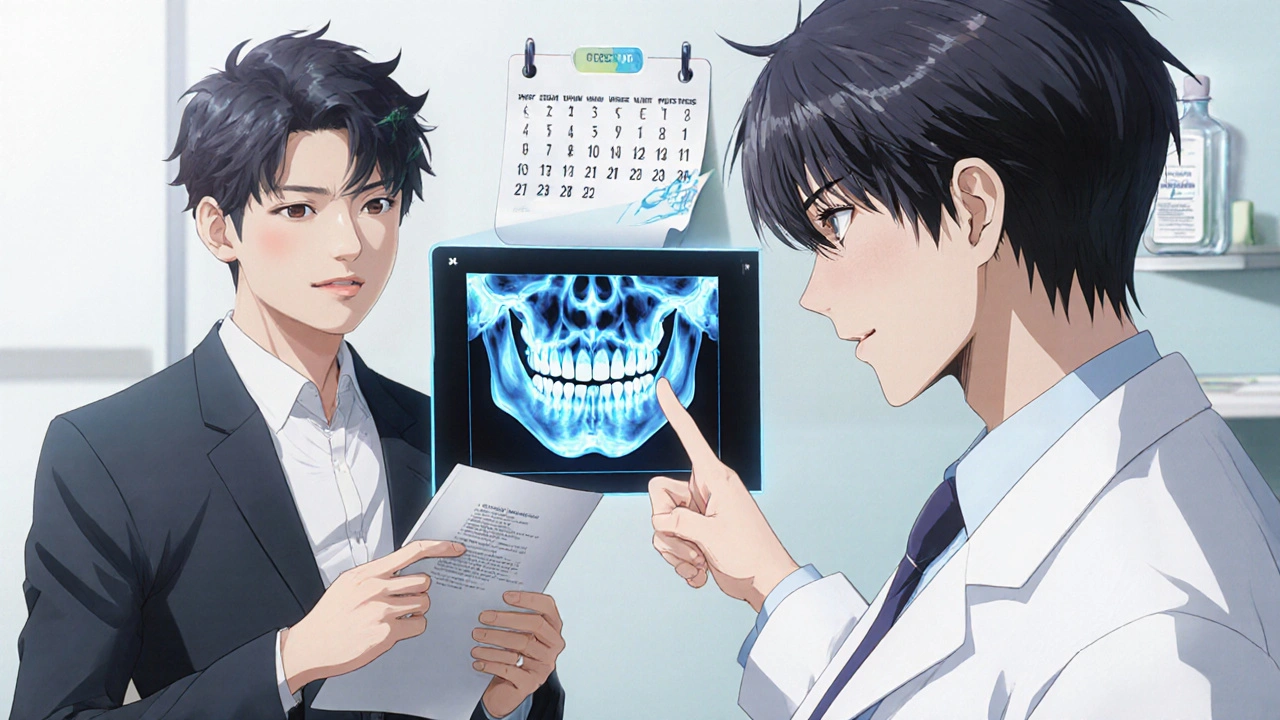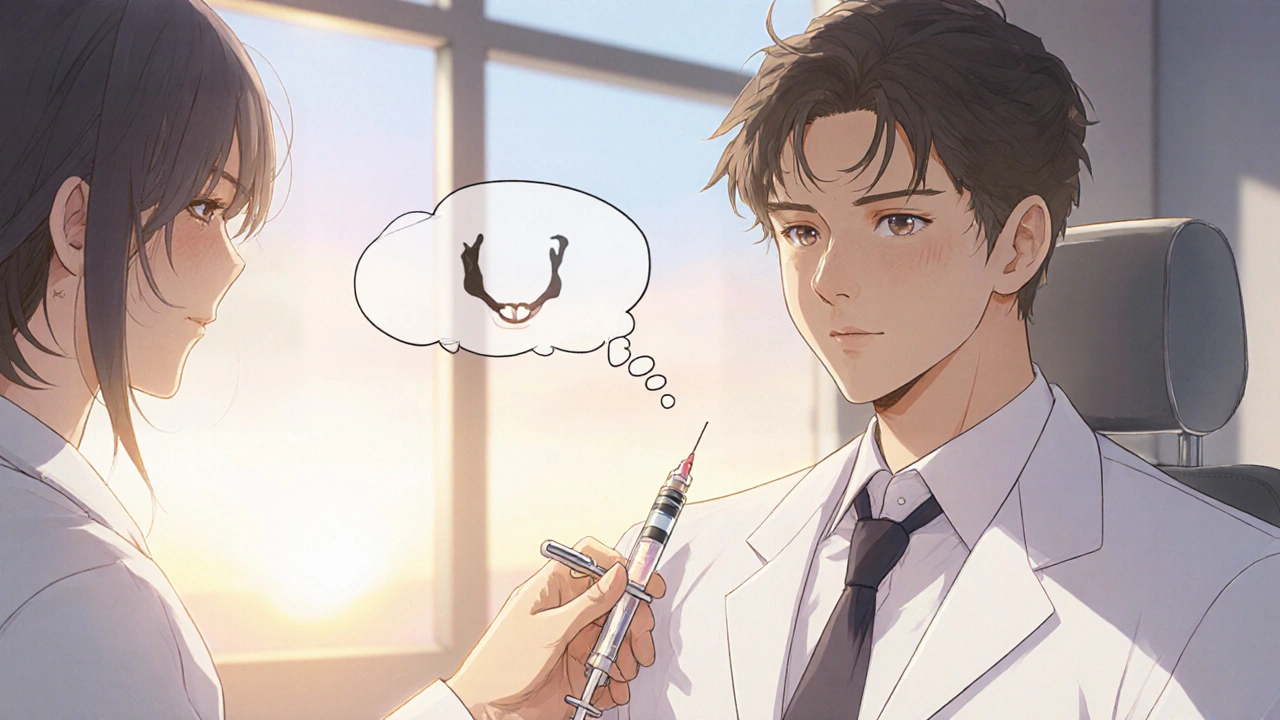MRONJ Risk Assessment Tool
Your Medication Risk Assessment
Dental Precautions Guide
Recommended dental clearance period:
- Oral bisphosphonates: 2-4 weeks before starting
- IV bisphosphonates: 4-6 weeks before starting
- Denosumab: 4-6 weeks before starting
When a doctor prescribes a bone‑strengthening drug, most patients focus on the benefit of fewer fractures. What they often overlook is a rare but serious dental problem that can turn a routine cleaning into a prolonged nightmare. That problem is jaw osteonecrosis, officially called medication‑related osteonecrosis of the jaw (MRONJ). Recognizing the early warning signs can stop the condition before bone loss becomes permanent.
What is medication‑related osteonecrosis of the jaw?
Medication‑Related Osteonecrosis of the Jaw (MRONJ) is a condition where exposed bone in the upper or lower jaw fails to heal for more than eight weeks, usually after a dental procedure or, less commonly, spontaneously. The bone essentially dies because its blood supply is blocked by drugs that suppress normal bone turnover.
Who is at risk?
Not every patient on a bone medication will develop MRONJ, but the risk climbs sharply with certain drugs, delivery methods, and treatment duration.
- Bisphosphonates - the original class linked to MRONJ. Oral versions (e.g., alendronate) carry an incidence of 0.001‑0.01% in osteoporosis patients, while intravenous forms (e.g., zoledronic acid) show rates up to 10% in cancer patients.
- Denosumab - a monoclonal antibody that also hampers bone remodeling. Risks are similar to high‑dose IV bisphosphonates when used for bone metastases.
- Duration matters. Studies from Edinburgh show the odds rise after three to four years of continuous therapy, climbing from 0.002% in the first year to 0.015% after five years.
- Other factors: diabetes, poor oral hygiene, smoking, and any invasive dental work performed while on therapy.
Dental warning signs you should never ignore
Early detection hinges on spotting subtle changes in the mouth. The most common red flags, backed by clinical data, include:
- Pain or swelling that lingers for weeks after a tooth extraction or cleaning (reported in 87% of cases).
- Gums that fail to close over a socket or extraction site-usually the first visible sign of exposed bone.
- Loose or shifting teeth without a clear reason (63% of diagnosed patients).
- Persistent gum infections that discharge pus (58%).
- Unexplained numbness, tingling, or a heavy feeling in the jaw (42%).
If any of these symptoms appear and you’re on a bisphosphonate, denosumab, or a similar agent, call your dentist right away.

How dentists confirm MRONJ
Diagnosis isn’t just a visual check. A thorough exam includes:
- Clinical inspection for exposed bone that has not re‑epithelialized for eight weeks.
- Radiographs or CT scans to reveal underlying sequestra or bone loss.
- Medical history review to verify the specific medication, dose, and length of treatment.
Because the condition can mimic a simple infection, a detailed medication list is essential. Many patients report that their dentist never asked about bisphosphonates-an oversight that delays diagnosis in up to 89% of cases.
Prevention: What you can do before and during therapy
The best defense is a proactive dental plan. Here’s a step‑by‑step checklist that most guidelines endorse:
- Schedule a comprehensive dental exam 4‑6 weeks before starting IV bisphosphonates or denosumab for cancer, and 2‑4 weeks before oral therapy for osteoporosis.
- Complete any needed extractions, deep cleanings, or periodontal treatment during this window.
- Ask the dentist to document a “clearance” note that you are free of active infection before the first dose.
- If you’re already on medication, discuss a possible drug holiday. For IV bisphosphonates, a 2‑3 month pause before major surgery can lower risk; oral agents may not need a break.
- Maintain meticulous oral hygiene: brush twice daily, floss, and use a 0.12% chlorhexidine mouth rinse twice a day after any invasive procedure. A 2021 trial showed a 37% risk reduction in high‑risk patients.
Even with these measures, occasional cases slip through. Knowing the early signs means you can catch them before bone loss spreads.

Medication risk comparison
| Medication | Route | Typical Dose (for cancer) | Incidence of MRONJ |
|---|---|---|---|
| Zoledronic acid | IV | 4 mg monthly | 1‑10 % |
| Alendronate | Oral | 70 mg weekly | 0.001‑0.01 % |
| Denosumab | Subcutaneous | 120 mg every 4 weeks | ≈1‑5 % |
| Romosozumab | Subcutaneous | 210 mg monthly | ≈0.1‑0.5 % |
Notice how the IV options sit at the top of the risk ladder. If you’re on one of these drugs, the dental clearance step becomes non‑negotiable.
What to do if you suspect MRONJ
Act quickly:
- Contact your dentist or oral surgeon immediately and share your medication list.
- Request imaging (panoramic X‑ray or cone‑beam CT) to confirm bone exposure.
- If early‑stage MRONJ is confirmed, conservative care-antibiotics, antiseptic rinses, and limited debridement-often resolves the problem.
- For advanced cases, referral to an oral‑maxillofacial surgeon is essential. Newer data suggest teriparatide can speed healing in stage‑1 lesions, with a 78% resolution rate in one trial.
Never attempt to pull a loose tooth yourself. Even a small trauma can push a hidden lesion into full‑blown osteonecrosis.
Key takeaways
- MRONJ is rare but serious; high‑dose IV bisphosphonates and denosumab carry the greatest risk.
- Watch for persistent pain, non‑healing gums, loose teeth, infection, or numbness.
- Pre‑treatment dental clearance and good oral hygiene dramatically lower the odds.
- If symptoms appear, get evaluated right away-early, conservative treatment works best.
Can I stop my bone medication if I develop MRONJ?
Stopping the drug may help the bone heal, but you must weigh the fracture‑prevention benefits against the jaw risk. Talk to your prescriber; they often suggest a temporary “holiday” while you receive dental treatment.
Do routine cleanings cause MRONJ?
No. The evidence shows that non‑invasive care like cleanings or fillings does not raise the risk. The problem mainly follows extractions, implants, or major gum surgery.
How long should I wait after a tooth extraction before starting a bisphosphonate?
Guidelines recommend a 2‑4 week healing period for oral bisphosphonates and 4‑6 weeks for IV formulations. Your dentist can confirm when the socket has fully closed.
Is there a cure for MRONJ?
Early‑stage disease often heals with conservative measures. Advanced cases may need surgery, and new therapies like teriparatide are showing promise, but complete cure rates vary.
Should my dentist be informed about every medication I take?
Absolutely. A full medication list lets the dental team tailor treatment plans and avoid procedures that could trigger MRONJ.
